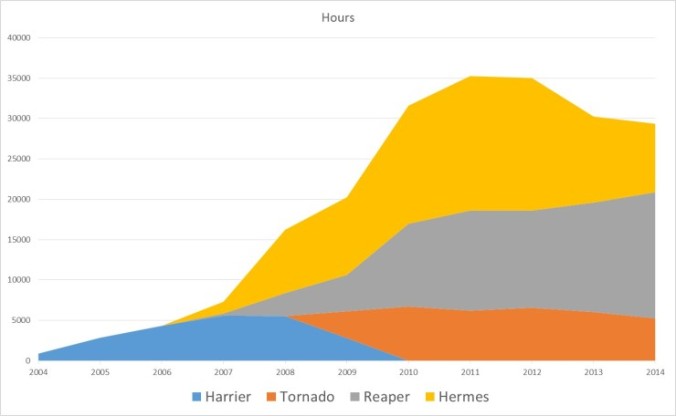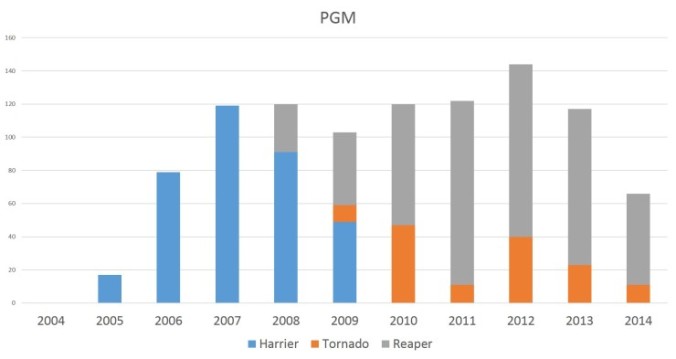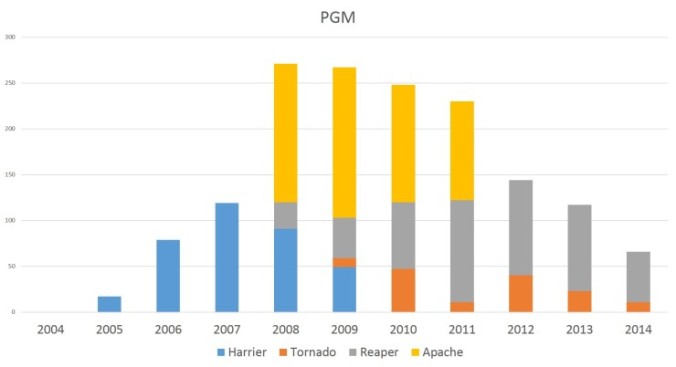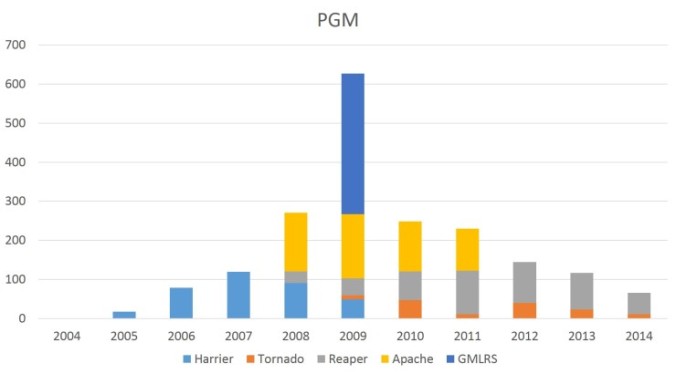A GUEST POST FROM ANDY C
The UK’s armed forces have shrunk considerably since the end of the Cold War and this sometimes leads to criticism. However, the nature and strength of the threat to the UK has also declined – by an even greater degree.
This paper argues for a sequential strategy for our defence posture. First, we must prioritise the defence of the UK itself. Second, is the security of our remaining sovereign territories. Third, are our regional international obligations to NATO, which also makes the UK itself more secure. Fourth, is our desire to participate in global intervention in partnership with our allies and global intervention by the UK acting alone.
Generally the current defence strategy meets the UK’s aspirations with the exception of a notable gap in anti-shipping and anti-submarine air power needed to protect our shipping lanes. As this is a necessary part of the defence of the UK itself it should therefore warrant the highest priority.
When suggesting Options the starting point is the minimum necessary force level to achieve the UK’s defence objectives and this has been used to inform Option 1. Both Land and Naval Commands are capable of meeting these minimum requirements with the budget and personnel numbers set out for them in Future Force 2020. The same cannot be said for Air Command. There is now a requirement to fly aircraft from both QE carriers, to re-establish a maritime patrol capability and expand the role of UCAVs. At the same time there is pressure on the QRA role from a resurgent Russia and on-going demands in the Middle East. This all means that Air Command will need additional financial resources and personnel even to meet its minimum necessary force levels. This degree of support needs to be a major commitment in SDSR 2015.
Recommendation 1: Air Command should be given additional resources out of the 1% real growth in the defence budget during this Parliament to operate 9 frontline Squadrons, 1 Maritime Patrol Squadron and double the number of UCAVs.
While Land Command does not require additional personnel to meet its minimum necessary force levels it does need to make changes to its overall structure. The Army needs to be re-balanced by withdrawing 4 regular Adaptable Force Infantry Battalions and 1 reserve Infantry Battalion and re-allocating personnel to cavalry, artillery, signals, engineering and logistic support. This will enable Land Command to commit a Brigade to long-term operations, field three full Divisions in a major crisis (including the capability to deploy the Challenger 2 main battle tanks held in storage) and bring back into frontline service the artillery and SAMs currently held in storage.
Recommendation 2: the British Army should be restructured through the re-deployment of 2,280 regular and 360 reserve troops from infantry units to cavalry, artillery, signals, engineering and logistic support.
In addition to these major recommendations this report makes a whole series of recommendations to improve the use of existing forces and to buy new equipment.
Recommendation 3: enhancements to existing defence capability should include:
- Land Command developing plans to maintain 144 currently surplus Challenger 2 main battle tanks in storage for use by three Light Cavalry Regiments in the Adaptable Force
- undertaking a Life Extension Programme for the 224 main battle tanks committed to the Reaction Force including replacing the gun and turret and so create a new Challenger 3 standard
- completing the Warrior Capability Sustainment Programme
- beginning the conversion of 272 Armoured Battlefield Support Vehicles (of which 180 would be anti-armour guided missile variants)
- upgrading 50 Apache WAH-64Ds to AH-64E standard
- integrating Brimstone 2 anti-armour missiles on to Apache, Wildcat and Lynx helicopters and
- Martlet lightweight air-to-surface missiles on its Wildcat helicopters.
- Naval Command refitting HMS Ocean to take over from RFA Argus
- upgrading 8 remaining Merlin HM1s to HMA2 standard
- integrating Sea Venom anti-shipping missiles on to all 38 Merlin HMA2s
- introducing ten AEW Crowsnest radars
- upgrading the Aster 30 long-range SAM for an ABM role
- integrating the Sea Ceptor short-range SAM on to all carriers, major amphibious ships, destroyers and frigates and
- equipping all Type 45 destroyers with Harpoon anti-shipping missiles.
- Air Command upgrading all tranche 2 and 3 Typhoons with Captor E-Scan AESA radar and 76 of them with conformal fuel tanks
- integrating the Meteor Beyond Visual Range AAM on to all Typhoons, any F-16s and all Hawks
- integrating Brimstone 2 anti-armour missiles on the Typhoon, F-35 and Protector UCAV
- modernising tranche 1 Typhoons with a more basic AESA radar
- enabling Typhoons assigned to air defence to carry six Meteor BVRAAMs plus four ASRAAMs
- developing a more manoeuvrable version of ASRAAM able to intercept air-to-air missiles
- introducing an Extended Range anti-shipping capable version of Storm Shadow
- equipping existing Hawk T2s with a basic AESA radar.
Recommendation 4: procurement orders required to maintain an effective minimum necessary defence (Option 1) should include:
- Land Command ordering 649 Ajax specialist reconnaissance vehicles to equip six Armoured Cavalry Regiments and nearly all Reconnaissance Troops and Platoons
- 1,014 Mechanised Infantry Vehicles to replace the aged Bulldog and the limited Mastiff plus 46 armoured ambulance variants
- introducing the remaining Watchkeeper Unmanned Aerial Vehicles
- 24 Land Ceptor short-range SAM launchers
- developing a Brimstone 3 ground launched medium-range anti-armour missile
- ordering 328 wheeled Common Support Vehicle to replace Land Ceptor SAM launch vehicles, Stormer Starstreak SAM vehicles, Warthog UAV support vehicles and Wolfhound vehicles for towed artillery
- replacing Land Rovers and Pinzgauers with up to 4,000 MRV(P)s and
- preparing for the replacement of the remaining Lynx, Bell 212 and Puma helicopters with either a medium sized helicopters such as the NH90, AW149 or EC725 or a combination of additional Wildcats and 14 Chinooks.
- Naval Command introducing the two QE class aircraft carriers
- receiving the remaining Astute class attack submarines
- introducing the Type 26 frigate into service
- equipping all Type 26 frigates with TLAM cruise missiles and Harpoon anti-shipping missiles
- adding the VL-ASROC anti-submarine missile to the ASW variant of the Type 26 frigate
- the Aster 30 long-range SAM to the general purpose variant of the Type 26 frigate
- ordering 3 MARS solid replenishment ships to support the carrier groups and
- receiving 3 offshore patrol vessels.
- Air Command receiving the remaining tranche 3 Typhoons
- 64 F-35B Lightning IIs
- ordering 12 long-range Maritime Patrol Aircraft, probably the P-8 Poseidon or Kawasaki P-1
- evaluating the effectiveness of the Triton UAV and a Sea Protector UCAV
- introducing 20 long-range Protector UCAVs
- developing a Meteor B to fit in the internal weapons bay of an F-35
- developing SPEAR 3 medium-range cruise missile for the F-35 and Typhoon and
- replacing remaining Hawk T1s with a mixture of 30 secondhand F-16s and 14 new Hawk 200s or 44 Hawk 200s all equipped with a basic AESA radar.
The list of enhancements, upgrades and orders for new equipment is very long. However, the procurement budget has been increased dramatically. There was £42.8 billion allocated to services but uncommitted to projects at the start of 2015, a further £10 billion unallocated to services and a £4.6 billion contingency.
In ‘An Abundance of Riches: MoD Procurement 2015-25’ below it is clear that there is enough funding to support production orders for all four Options outlined in this report. If the projects outlined can be kept to budget there is a potential underspend of £1.6 billion. If £700 million of this were re-allocated from procurement to current spending at the rate of £100 million per year from 2018/19 it would go a long way to funding an enhanced defence capability.
Recommendation 5: re-allocate £100 million per year from the equipment budget to current spending in each year starting from 2018/19 to fund as many as possible of the enhanced capabilities listed in Options 2-4.
| SDSR Option 2 |
|
| Land Command |
Equip all Adaptable Force Infantry Battalions with Mechanised Infantry Vehicles |
| Naval Command |
As Option 1 but with a new LHD helicopter carrier |
| Air Command |
Operate 9.33 frontline and 12.66 fast jet combat Squadrons with 6 F-35B Squadrons |
Additional procurement totals 540 Mechanised Infantry Vehicles, 38 F-35Bs, 1 LHD helicopter carrier and 24 Ajax vehicles. Refurbish an additional 48 Guided ABSVs.
| SDSR Option 3 |
|
| Land Command |
As Option 2 but retain all Lynx AH9As |
| Naval Command |
As Option 2 but retain 3 River class 1 offshore patrol vessels |
| Air Command |
Operate 10.33 frontline and 13.66 fast jet combat Squadrons with 6 F-35B Squadrons |
Additional procurement totals 540 Mechanised Infantry Vehicles, 38 F-35Bs, 1 LHD helicopter carrier and 24 Ajax vehicles. Refurbish an additional 48 Guided ABSVs and 2 Merlin HMA2s.
| SDSR Option 4 |
|
| Land Command |
As Option 3 but refurbish an additional 16 Apache AH2s |
| Naval Command |
As Option 2 but retain three Type 23 frigates |
| Air Command |
Operate 11.33 frontline and 14.66 fast jet combat Squadrons with 6 F-35B and eventually 2 F-35A Squadrons |
Additional procurement totals 540 Mechanised Infantry Vehicles, 38 F-35Bs, 36 F-35As, 1 LHD helicopter carrier, 8 Merlin HMA2s and 24 Ajax vehicles. Refurbish an additional 48 Guided ABSVs, 16 Apache AH2s and 2 Merlin HMA2s.
Appendix 4: An Abundance of Riches, MoD Procurement 2015-25
“An Abundance of Riches” is an accurate description of the growing size of the equipment procurement budget. This analysis illustrates that the existing procurement budget should be sufficient to afford all four of the Options outlined above.
This assessment is based on the MoD’s defence equipment plan 2014 which can be found here https://www.gov.uk/government/publications/the-defence-equipment-plan-2014.
The MoD report provides plenty of detail that can be used to assess the state of the procurement budget by service. To get an accurate picture of the procurement position in SDSR 2015 there remains one important caveat. The figures in this report are already twelve months old so to get the true picture we have to remove the numbers for 2014/15 and add in estimates for 2024/25 based on repeating the figures for 2023/24.
For each budget heading this analysis examines the ‘Equipment Procurement (Uncommitted)’ figure. As the report is a year old we need to include the contracts that have been signed in the last twelve months. The budget headings below are those used on pages 18-31 but have been re-ordered for the largest to go first:
Submarines – £19.1 billion in Uncommitted Equipment Procurement
Included in this are boats 5-7 of the Astute class but the vast majority of this huge total is the Trident Successor Programme and the maintenance of the nuclear deterrent. Under the last government this remained ‘uncommitted’ due to the politics of the Coalition. As this is the MoD’s largest procurement project it provides the greatest risk to the overall budget and will require the closest management. However, any cost overruns can be controlled by delaying in-service entry and should not present a threat to the project as a whole. The Submarines budget is therefore fully committed.
Land Equipment – £8.9 billion in Uncommitted Equipment Procurement
Included in this are contracts of £3.5 billion for Ajax specialist reconnaissance vehicles and £1.3 billion for the Warrior Capability Sustainment Programme. There’s now a separate budget heading for the Armoured Battlefield Support Vehicle adaptation of the Warrior set initially at £100 million for 65 APCs and ambulances. Coming up is the Challenger 2 Life Extension Programme to cost £700 million for a basic upgrade and a new amphibious all-terrain vehicle for the Royal Marines at a cost of £230 million. Then there’s the Mechanised Infantry Vehicle. An order for 1,014 could replace the Bulldog and Mastiff and so equip the majority of Infantry Battalions. For an 8×8 wheeled vehicle such as VBCI or Piranha V that would cost about £3 billion. The Land Equipment budget is therefore fully committed.
Ships – £6.5 billion in Uncommitted Equipment Procurement
Included in this is the contract of £350 million for Offshore Patrol Vessels. Coming up is the start of the Type 26 programme. Even with budget growth it’s unlikely that the cost of this will rise above £2.5 billion before 2025. There is also a requirement for three MARS solid replenishment ships, if they are tendered for commercially that should keep the cost under £500 million. Finally, there’s a requirement to replace RFA Argus. If this can’t be done by refitting HMS Ocean then a new ship will be required – if the Royal Navy bought one of the French Mistral’s or a similar ship it should cost no more than £500 million.
Even after taking into account all of these items there’s still £2.6 billion uncommitted. In the long-term there will be a need for new amphibious ships and the replacement of a whole range of smaller ships but neither of these is necessary prior to 2025. A total of £2.6 billion could therefore be returned to Central Provision to be allocated for the F-35B and Maritime Patrol Aircraft.
Combat Air and Air Support – £6.3 billion in Uncommitted Equipment Procurement
Included in this are the contracts of £2.6 billion for 14 F-35Bs including support requirements, £500 million for new basic and elementary training aircraft, £300 million for the development and integration of Captor E-scan radar and £200 million for Brimstone 2 integration and the development of a common weapons launcher for the Typhoon. Coming up is the order to bring the number of F-35Bs up to 48 as committed to in SDSR 2010 (this could be as much as £2.4 billion), a further £300 million on manufacture of the Captor E-scan radar and £300 million for 20 new long-range Protector UCAVs. With the initial work on the new Typhoon radar being paid from underspending in 2013 this means that the Air budgets are fully committed.
Helicopters – £2 billion in Uncommitted Equipment Procurement
Included in this are the £500 million contract for Crowsnest radar for Merlin helicopters and coming up soon is a requirement for new helicopter trainers which could cost £200 million. There is up to £1 billion available to purchase 50 new Apache AH-64E attack helicopters or upgrade all 66 existing Apache WAH-64D attack helicopters, £200 million to upgrade eight more Merlin HM1s to HM2 standard and a further £100 million to integrate Brimstone 2 on to the Apache and the Army’s Wildcats and Lynx’s. In addition there could be a further £100 million for integrating Sea Venom on to Merlin’s and Martlet on to the Army’s Wildcats. That leaves £400 million to replace the Bell 212 and Special Forces’ Lynx AH9As with either 16 additional Wildcats or a new medium sized helicopter. As the Crowsnest radar is also being paid from the 2013 underspend this means the Helicopters budget is fully committed.
Unallocated Headroom and Central Provision – £10 billion
Effectively, the budgeting here has covered all of the outstanding commitments from SDSR 2010 plus there’s a surplus from the Ships budget of £2.6 billion that can be re-allocated.
Altogether that gives a total of £12.6 billion in uncommitted equipment procurement that can be allocated in SDSR 2015. If required funding up to Option 4 is achievable by 2024/25 with:
- £2.4 billion out of a total order of £4.3 billion for an additional 54 F-35s. Ordered at a rate of 12 per year from 2020 the total numbers would reach 102 in 2026. This assumes a unit cost of £80 million which could be less as the production rate accelerates;
- £3.6 billion for 12 Maritime Patrol Aircraft (including a replacement for Sentinel R1) as well as up to 12 maritime UAVs;
- £350 million out of a total order of up to £1.1 billion for the replacement of remaining Lynx and Puma helicopters with either 38 medium sized helicopters such as the NH90, AW149 or EC725 or a combination of an extra 14 Wildcats and 14 Chinooks;
- £300 million out of a total order of £1.7 billion for a further 540 MIVs and 46 armoured ambulances to replace all other remaining infantry vehicles in the Adaptable Force by 2029;
- £650 million to develop and order a total of 328 wheeled Common Support Vehicles to replace Land Ceptor SAM launch vehicles, Stormer Starstreak SAM vehicles, Warthog UAV support vehicles and Wolfhound vehicles for towed artillery. This could be a turretless variant of the Utility Vehicle;
- £650 million to replace the remaining 44 Hawk T1s with a variant of the Hawk 200 and/or secondhand F-16s;
- £600 million for the conversion of an additional 255 ABSVs, with 228 of the total equipped to carry medium-range guided anti-armour missiles;
- £600 million for 121 basic AESA radars for tranche 1 Typhoons, any F-16s and all Hawks plus Meteor integration on tranche 1 Typhoons, any F-16s and all Hawks;
- £500 million for a new gun and turret to increase the effectiveness of 224 main battle tanks and upgrade them to Challenger 3 standard;
- £450 million for an additional 84 Ajax specialist reconnaissance vehicles;
- £400 million for up to 4,000 MRV(P)s;
- £350 million for 8 new Merlin HMA2s;
- £100 million to fit 76 tranche 3 and 2 Typhoons with conformal fuel tanks and;
- £50 million for the refurbishment of two additional Merlin HMA2s.
This still leaves £1.6 billion left uncommitted in Central Provision.
Also, if the whole MIV purchase was spread evenly across the decade from 2020 to 2030 it would reduce the cost of this programme by £950 million up to 2024/25.
And then there’s £4.6 billion in the contingency reserve as well!
The Major Projects in 2015-25 spending over £1 billion each are:
- £14.4 billion Trident Successor Programme
- £7.4 billion F-35B Lightning II
- £4.7 billion Astute attack submarine
- £3.95 billion Ajax specialist reconnaissance vehicle
- £3.6 billion Maritime Multi-Mission Project
- £3.3 billion Mechanised Infantry Vehicle
- £2.5 billion Type 26 frigate
- £2 billion Warrior Capability Sustainment and Armoured Battlefield Support Vehicle
- £1.2 billion Challenger 3 Life Extension Programme
- £1.15 billion additional Typhoon enhancement
- £1 billion Attack Helicopter Capability Sustainment Programme.



